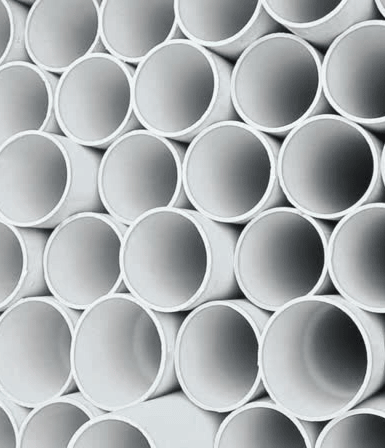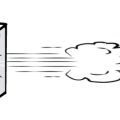Hey! This site is reader-supported and we earn commissions if you purchase products from retailers after clicking on a link from our site.
We get quite a number of questions about whether or not it is a good idea to use PVC air lines to plumb compressed air, this page will provide you with all the relevant information on whether this is a good idea or not!
Table of Contents
- PVC Pipe for Air Lines
- Problems With Using PVC Piping With Compressed Air
- Special PVC Pipe For Air Lines
- Why You Should Not Use PVC Piping for Your Compressed Air Lines
- Alternative Materials for Compressed Air Line Piping
- FAQs (Frequently Asked Questions)
PVC Pipe for Air Lines
Since PVC pipe appears to be very well priced when compared against other materials for plumbing and on top of this, the installation is pretty easy with typical, around-the-house plumbing tools.
PVC is cheap, readily available and works well with a variety of applications including transporting liquid. Given its versatility and ruggedness, you can see why plenty of folk use it for compressed air lines.
So, do you, or do you not, use PVC pipe to plumb your compressed air lines?
PVC pipe is poly-vinyl chloride. If you look at the manufacturers markings on the pipe, it will often say that the pipe is pressure rated for 140 PSI or 150 PSI, somewhere in that range, depending on the manufacturer and the pipe diameter.

Problems With Using PVC Piping With Compressed Air
There are a number of problems that’ll occur when using PVC piping with compressed air and these include:
- misleading pressure ranges
- pipe could shatter
- age and temperature of pipe
- how the pipe has been sealed
Now let’s take a look at these in more detail.
Misleading PVC Pipe Pressure Ranges
The problem with considering using PVC pipe for compressed air lines at the pressure levels stenciled on the pipe, is that folks may not read the whole specification. That listed pressure is temperature specific which means that as the temperature changes, so too does the pressure rating of the PVC pipe.
Does the temperature ever get to 90-100 degrees Fahrenheit or even hotter where you live? If it does, then the pressure rating of your PVC pipe just dropped dramatically.
All of a sudden, a 120 PSI air pressure inside the pipe when the outside air is cool, will cause ruptures as the pressure rating for that PVC pipe has dropped below the danger level due to the temperature rising where it has been installed.
Age and Temperature of PVC Pipe
PVC becomes far more brittle as it ages and as the temperature drops. This directly affects the pressure ranges of the PVC pipe, as the PSI ratings can only really be trusted when the pipe is new and sealed properly.
PVC pipe degrades significantly over time with its structural integrity becoming fairly compromised, and thereafter prone to shattering.
PVC Pipe Could Shatter
If you over pressurize PVC pipe, your pipe could undergo catastrophic failure, with disastrous and life threatening results. It does not just form a bubble and then pop, which is what happens to polyethylene tube when you overpressure that material.
When a PVC pipe lets go, it shatters. All of a sudden you could have sharp plastic shards of pipe flying and ricocheting all over your garage, workshop, plant causing damage and harm to anything in its path.
How the PVC Pipe Has Been Sealed
Another common problem with PVC in general is how the PVC pipe has been sealed. The pipe though easy to install, can be difficult to prevent leakages through not sealing it properly.
PVC cement often does not get the adequate time it needs to properly set or thread sealant like PTFE fails due to improper application. This causes the air system to become dangerous and potentially ineffective.
Special PVC Pipe For Air Lines
I do know that there are manufacturers that make a PVC blend pipe they claim is suited for using as piping in a compressed air system. I suspect this material will be priced at a level that may make the traditional compressed air plumbing materials shine in comparison.
I know that before you use any PVC material to plumb any pressure of compressed air, you do want to contact the manufacturer and get them to confirm, in writing (emails are wonderful), that their material is suitable for use in a compressed air plumbing applications.
Why You Should Not Use PVC Piping for Your Compressed Air Lines
I will not recommend the use of PVC air lines, and by now I’m sure you probably share that mind set. The problems previously described should be enough reason to persuade you and if not, well it’s actually against OSHA (Occupational Safety and Health Administration) standards to use PVC piping for above ground transportation of compressed air and gases.
In doing so, you will run the risk of OSHA giving you heavy fines and potentially even your business being shutdown if you have too many violations.
Many manufacturers of PVC pipe even say themselves or place warning labels on their packaging stating how the pipe should not be used in the transport of compressed air or gases due to the large safety risks.
If you’re contemplating make a homemade PVC air tank, please first visit our Dangers of PVC Air Tanks page!
Alternative Materials for Compressed Air Line Piping
So now you must be wondering what material you can use if not PVC? We have a variety of metal and plastic piping options that all have advantages and disadvantages you must consider.
In order of materials that I would choose for plumbing my compressed air, and if price were no object, I would pick copper pipe as the best route for problem free compressed air plumbing.
Next I would use rubber air hose (see the air compressor hose guide for more information), and if I did not need a high flow of air, my next choice would be polyethylene tube.
Yes, polyethylene tubing is a plastic. It is a different family and formula than PVC however, and I can tell you from personal experience, that if you over pressurize the P.E. Tube, all that happens is that a bubble forms at a weak spot, the bubble grows, and eventually, the bubble pops rather than completely shattering.
Yes, you lose air when the tube pops, but there is no real safety issue with using P.E. tube that is rated for industrial air pressures. And in addition to P.E. there is PEX or even PEX-AL-PEX. Where the polyethylene is cross-linked (x) and then sandwiched with a layer of Aluminum in the middle.
Next, and way down on the list, but sometimes necessary due to the relative low cost and the large pipe diameters available for air mains, is black pipe for air lines. It has drawbacks including difficult installation and the generation of rust and debris inside the pipe as time goes on, but black pipe has its proponents too.
All of these air-line plumbing products and more are discussed at length in our best compressed air pipeline materials guide!
FAQs (Frequently Asked Questions)
The use of PVC pipe for air lines is not recommended as the material is suspect to getting brittle over time and then not only cracking or breaking, but shattering and releasing shards dangerously in all directions.
Pex is not specifically rated for compressed air systems and is susceptible to UV damage however, Pex-Al-Pex can deal with high pressures in compressed air systems as it has little or no vapor permeability.
The amount of pressure PVC can hold varies significantly with a change in temperature. When PVC pipe temperature is high the rating of the pipe (or how much pressure it can hold) drops and raises the possibility of an explosion. It cannot hold pressure as well as other materials for piping.
Additional Reading:
- Using Aluminum Air Pipe For Compressed Air
- Copper Pipe For Compressed Air
- Galvanized vs Black Pipe For Air, Gas And Water
- Using ABS Pipe For Compressed Air
- Using Nylon Tubing For Compressed Air
- Using Pex Pipe for Compressed Air Lines – Do’s & Don’ts
- Best Compressed Air Pipeline Materials For Compressed Air Piping Systems
- Steel vs Brass Air Fittings
- Industrial vs Automotive Air Fittings
- Compressed Air Metric Fittings
- Air Hose Fittings Types – Guide To Air Compressor Coupler Types
- Compressed Air Fittings Guide
- Air Compressor Hose & Tube Guide
- Using Pex-Al-Pex Compressed Air & Pex-Al-Pex Fittings
- Pex A vs Pex B Pipe & Fittings
- PEX Fitting Types Guide
- How to Plumb an Air Compressor Setup in Garage
If you have any questions regarding PVC air lines then please leave a comment below with a photo if applicable so that someone can help you!





